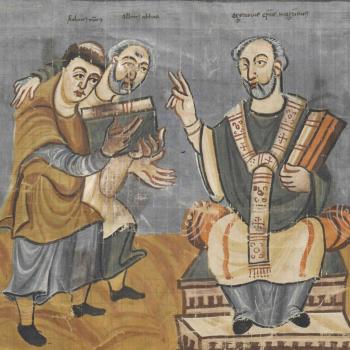Not having seen the big production new film of Mary Magdalene (Joaquin Phoenix, Rooney Mara, Chiwetel Ejiofor), I can’t comment on it. And for interesting reasons I will explain, don’t expect to see it in the US any time soon. But I will respond to the latest wave of comments that this film has drawn forth about the widespread and powerful myth concerning Mary Magdalene herself – and myth it assuredly is.
In the British Daily Telegraph, Peter Staniford writes a lengthy piece on “how the ‘apostle to the apostles’ had her name dragged through the mud.” In the new film, she is present at the Last Supper, and says Stanford, rightly so – “this virtuous woman being as significant among Jesus’s inner circle as all the other men gathered there. She too is an apostle, the equal to Peter, Andrew, James and John. It’s certainly a radical shift from the Mary Magdalene of traditional Christian lore, who has come to be known as an embodiment of loose morals: a wanton prostitute, the tart with a heart who is rescued from her sinful ways by Jesus.” The film “will contribute to the long-overdue rehabilitation of Christianity’s most slandered figure.”
If true, this is a powerful argument for modern-day Christian feminists. If Mary Magdalene herself was such a critical figure in the early church, even an apostle, how dare any modern institution fail to recognize women’s spiritual gifts? This is a prime example of the silencing of women’s voices.
But Mary’s story contains some real mysteries that we are a long way from solving. And no, I’m not referring to the twentieth century fantasy about her marrying Jesus and spawning a royal bloodline somewhere in France.
Modern accounts of Mary Magdalene usually tell a sinister story of misconduct by male church authorities. Mary, we are told, was the primary witness of the Resurrection, and must have exercised real authority in the early Christian community. Widely circulated alternative gospels recorded her mystical dialogues with Jesus. Over time, though, she dropped from the picture. Those “Other” gospels were banned, and vanished from sight for centuries.
Worse, church leaders decided to identify her with other women reported in the gospels, and not to her advantage. By the sixth century, Pope Gregory the Great identified her as the penitent prostitute who humbled herself before Jesus, and this stigma has lingered until modern times. (An Orthodox Christian friend properly reminds me that this identification prevailed in the West not the East, where Mary has always been venerated simply as Equal to the Apostles, with no trace of a sordid past).
Modern writers see the Western/Papal transformation not as an innocent error of interpretation, but as a cynical attempt by a patriarchal church to smear an embarrassingly powerful woman. In later centuries, “Magdalene Homes” catered to saving women fallen into sexual sin. That’s quite a comedown for someone who was allegedly one of Jesus’s closest companions.
Reporting on the work of scholar Karen King, an article in Smithsonian magazine remarked that Gregory’s reading “simultaneously diminished Magdalene and set the stage for 1,400 years of portrayals of her as a repentant whore, whose impurity stood in tidy contrast to the virginal Madonna.” The suggestion is that the church deliberately cultivated devotion to the Virgin Mary to distract attention from the subversive Magdalene.
Actually, we can exaggerate the degree of malice suggested by that familiar Magdalene myth. The gospels that starred Mary were much later than the canonical accounts — by a century or more — and they relied on them entirely for any historical information about Jesus’s life and times. Historical concerns fully account for these texts’ exclusion from the church’s canon.
Even with her sordid back-story, Mary Magdalene simply was not airbrushed out of the church’s history. She continued to be highly venerated in medieval times and afterwards, one of the most beloved popular saints. Both Oxford and Cambridge universities commemorate her with their ancient and very prestigious Magdalene Colleges. Still in the fifteenth century, the English translation of the vastly influential Golden Legend exalts Mary as she “to whom Jesus Christ appeared first after his resurrection, and was fellow to the apostles, and made [by] our Lord apostolesse of the apostles.” That hardly sounds like someone being written out of history, or indeed slandered.
And yes, over five hundred years ago, the English language had a feminine form of “apostle.”
But it is the Resurrection stories that are most puzzling, and which raise most doubts about the Magdalene myth. A typical reader of the New Testament may well think that Mary was pivotal to the story of Jesus’s death and Resurrection. She was one of the small band present at the crucifixion, and (depending on which account you read) she either met the risen Jesus, or was the first to report the event. Later on in the Bible, we move to Paul’s extensive letters, in which her name never features. Surely here we see evidence of the patriarchal cover-up?
The problem is that the New Testament books do not appear in the order in which they were written. The true sequence of writings goes like this. Somewhere around 55 AD, Paul wrote about Jesus’s post-Resurrection appearances, and he began with Peter (Cephas). We then have the famous credal list in 1 Corinthians 15: “he appeared to Cephas, then to the twelve Then he appeared to more than five hundred brethren at one time, most of whom are still alive, though some have fallen asleep. Then he appeared to James, then to all the apostles.” So where is the Magdalene here?
Twenty years after that, Mark’s gospel ends with an angel telling a group of women, including Mary Magdalene, about the Resurrection, but the text as it survives today says nothing about appearances by Christ. It’s a long story that I won’t go into here, but I believe that scene would originally have foreshadowed the actual first Resurrection appearance, which was to Peter in Galilee.
Twenty years after Mark, perhaps in the 90s, Luke tells a similar story about the women reporting what an angel told them about the Resurrection, but not witnessing it. Again, Mary is just one of a group. Luke records the proclamation that “The Lord has risen indeed, and has appeared to Simon!” This was a standard formulation, and in fact the oldest Christian creed.
About this time, though, a new element emerged in the tale, namely that the group of women went beyond hearing about Jesus, but actually met him. This is the story we find in Matthew — although Mary is only one of a pair of witnesses, with “the other Mary.”
Last in the sequence, and not much before 100, John’s gospel tells us the story that has become most famous, and will be central to so many sermons this coming Easter. Peter discovers the empty tomb, but it is Mary Magdalene herself (solo, not just one of a group of women) who is the first to have a personal meeting with the risen Jesus, who has a hauntingly beautiful conversation with her. Overjoyed to see Him, she reaches to touch Him. No, He says, not until I have ascended.
John’s tale of the encounter is touching and memorable, and it is not surprising that it has attracted so many artists through the centuries. But as a historical account, it is much later than the others, and much less likely to reflect the views of the earliest Christian community.
The first references to Mary receiving a special Resurrection appearance were thus written seventy years or so after the supposed event. If you had asked a Christian before the 70s (say) about the Resurrection, Mary Magdalene would have featured nowhere in the story, except maybe in foreshadowing the actual event.
Mary Magdalene herself makes no appearances in the New Testament outside the gospels, and is rarely mentioned by the group of very early writers we call the Apostolic Fathers. Only in the third century pseudo-gospels does she become the spiritual superstar who receives Jesus’s special revelations.
So we have everything neatly tied up. The early church told of a Resurrection appearance to Peter and then the whole body of disciples. Although there might have been early tales concerning the faithful women, this element became much more prominent over time, until eventually one heroine took center stage as key witness to resurrection, and that was Mary Magdalene.
But wait a moment…
We can easily imagine an institution reinventing its origins to cover up embarrassing elements. But has any religion ever deliberately gone out of its way to make its beginnings less rather than more plausible?
Over time, the church’s developing literature placed ever-greater reliance on women as key witnesses for a profoundly improbable event. Of course, women’s testimony carried little weight in the courts of the time. Even worse, the central figure is Mary Magdalene, and as Luke tells us, seven demons had been cast out of her. In modern parlance, that language suggests mental disturbance or personality disorder.
Anti-Christian critics had a merry time with this idea. Around 180, the pagan writer Celsus mocked any claims of Christ’s Resurrection that relied on a “hysterical woman,” or crazy lady (gyne paroistros). Either she was creating a wish-fulfillment fantasy about a dead boyfriend — perhaps her pimp? — or else she was inventing silly stories to impress the derelicts and street people she wandered around with.
Would an intelligent Christian author really have invented a legend of Mary Magdalene, if he or she had any hope of preaching Jesus’s claims to a wider world?
So where does that leave us? Just conceivably, the early church as an institution might have known early stories about the Magdalene’s role as a resurrection witness, and suppressed them out of embarrassment at her past, and her claims to be a plausible witness. It’s possible, but wildly unlikely.
Instead, we have to remember that virtually everything we hear about the special relationship between Jesus and the Magdalene comes from one scene in one gospel, and should be understood as the literary creation of that one author. Perhaps the author of John’s Gospel just found the Resurrection meeting scene so wonderful that he could not resist writing it, even if he had to bury the other material he must have known, including Mary’s seven demons. Sometimes, an artist just has to create, and never mind the consequences. Over many centuries, that outlying story became the standard popular vision of the Resurrection.
And that author’s creation is the foundation of what has become a whole alternative myth-history of early Christianity.
If you are hoping to see the new film with its powerful feminist themes, there is a certain irony about its current fate. Briefly, blame Harvey Weinstein. According to the BBC, “Mary Magdalene was to have been released in the US by The Weinstein Company. Yet the collapse of that company in the wake of the sexual harassment claims made against Harvey Weinstein has left its future uncertain.” In this very current instance, maybe, patriarchal misconduct genuinely has silenced the story of Mary Magdalene.
I am adapting some material here from a column I published at Real Clear Religion back in 2013.
















